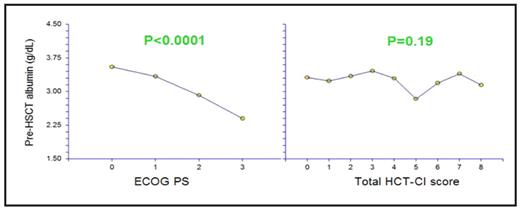Abstract
The hematopoietic cell transplantation-comorbidity index (HCT-CI) has been proposed as a means to estimate the risk of transplant-related mortality (TRM) and the likelihood of overall survival (OS) after allogeneic HSCT. However, its value and applicability remain unclear; in a 2-center study, it was predictive of outcome at one but not at the other in multivariate analysis (
We investigated the effect of HCT-CI in 130 adult patients with hematologic malignancies undergoing reduced-intensity HSCT after 100 mg/m2 melphalan (+ 50 mg/kg cyclophosphamide if no prior autograft). GVHD prophylaxis comprised cyclosporine/tacrolimus and MMF. 18% of the donor-patient pairs were 1 antigen/allele-mismatched. 57% had refractory disease. 45% had failed an autograft. ECOG performance status (PS) was 0–34%, 1–48%, 2–14%, and 3–4%. The HCT-CI score distribution was 0–10%, 1–4%, 2–28%, 3–24%, 4–15%, 5–10%, 6–8%, and ≥7–2%. Overall, the patient population had higher HCT-CI scores than described in other studies (
In multivariate analysis, TRM was higher with HLA mismatch and PS 2-3, and OS was lower with PS 2-3, HLA mismatch, refractory disease, donor age >45 y, elevated LDH, and platelets <100.
HCT-CI 0 vs 1-2 vs ≥3 had no effect on TRM or OS. HCT-CI 0-2 vs ≥3 had a borderline effect on TRM (P=0.09) and OS (P=0.15) in univariate analysis, but no effect in multivariate analysis when forced into the model with factors known to be significant. No significant correlation was seen between HCT-CI and any of the factors found to be predictive of outcome.
Because serum albumin is a powerful non-specific predictor of general health and outcome in all clinical situations, we hypothesized that it would correlate with the PS. As shown in the figure below, it did. We expected that it would correlate with HCT-CI because increasing comorbidity should theoretically be associated with declining albumin. However, it did not.
In our experience, HCT-CI does not correlate with outcome – especially when other pertinent factors are taken into account. Since most data supporting HCT-CI have originated from a single center, it is possible that its applicability depends on individual centers and the treatment protocols employed. However, lack of correlation of HCT-CI with albumin does call its biological plausibility into some question. HCT-CI cannot be employed unless refined and validated prospectively in multi-center studies.
Disclosures: No relevant conflicts of interest to declare.
Author notes
Corresponding author



This feature is available to Subscribers Only
Sign In or Create an Account Close Modal